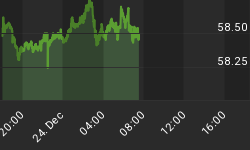Investor need for riskier assets continued to support the Euro this afternoon. In addition, the U.S. Dollar extended its losses following the release of the Fed's FOMC minutes. Traders reacted to the minutes which showed Fed members were considering increasing Fed purchase of mortgages and government debt. This act would debase the Dollar further and may lead to inflation if done incorrectly. This was the main reason for the late session selling pressure.
The strong surge to the upside took out last week's high at 1.3722 and negated the developing reversal top. This market is now trading above a major 50% price at 1.3587 and rapidly approaching the Fib retracement level at 1.3854. Regaining the bull side of the Fibonacci price will indicate higher prices to follow.
Trend traders are having no problems as the market is clearly making higher tops and higher bottoms. In fact, the trend will not be threatened unless 1.3422 is violated.
Remember that this market is being driven by speculation that an economic recovery is just beginning. The European Central Bank has been warning that a recovery will be slow but traders still feel the need to take on the extra risk at this time. The best warning signal that a short-term top is forming will be a closing price reversal top on either an hourly or daily chart.
British Pound investors continued to bet heavily on a quick recovery in the U.K. economy by sending the currency soaring to a multi-month high.
Strong rallies in global equity markets helped push this currency even higher as trader appetite for higher paying assets helped increase trader optimism that a global economic recovery will come sooner rather than later.
Fundamental factors such as a global stock market recovery and a more optimistic outlook for manufacturing are helping to support the market. Technically, the crossing of the 200-day moving average contributed to the surge by triggering stops.
This entire rally is based on speculation that the U.K. economy is on the path to recovery although recent economic reports and the Bank of England still indicate that there is apparent weakness in key sectors. The BoE just last week warned that the recovery would be long and labored. This is raising the question as to whether this current rally is starting to get too far ahead of itself.
A report showing that Canadian inflation was in line with expectations helped to break the USD CAD on Wednesday. Traders were concerned that a drop in inflation would trigger the need for the Bank of Canada to apply quantitative easing in an effort to revive the economy.
Now that the BoC knows that there is a diminished threat of inflation, it is unlikely to interfere with the current economic recovery. The BoC is now going to monitor how much of an effect a stronger currency will have on the Canadian export market.
Now that this pair has broken out below a support price at 1.1474 the way of least resistance appears to be to the downside. The first downside target is 1.1059, followed by 1.0586.
Strong support for the Canadian economy is coming from the surging crude oil market, but weakening equity markets could help to limit gains in the Canadian Dollar.
The USD JPY broke sharply lower on Wednesday despite a report showing that the Japanese economy contracted at an annualized rate of 15% during the first quarter. This number was better than economists' forecasts which may be one reason for price improvement today.
The weakness in the USD JPY and the strength in the equity markets do not make sense at this time. It seems one side has to give. Recently investors have been selling Yen to finance the bull market, but today's action may be indicating that they are not supporting an equity market rally at this time.
Another reason why long traders have to be careful is because of comments from the Bank of Japan this week. The BoJ issued a statement expressing its concerns about excessive volatility in the Yen as well as current lofty price levels. Gains may be limited to the upside as traders remain hesitant to jump in front of the BoJ.
Trend traders should note that the current downtrend will be reaffirmed by a trade though 94.54. This should put the USD JPY on target for a test of a major 50% price at 94.28. A short-covering or profit-taking rally could develop following a test of this level.
The main trend remains down for the USD CHF. A new swing top was also formed at 1.1265, indicating developing weakness as the lower-top, lower-bottom formation continues. The trade through the last swing bottom at 1.0976 reaffirms the current downtrend.
This currency is trading inside of a major support zone at 1.1168 to 1.0980. Holding below 1.0980 will be a strong sign that lower prices will follow. If the market regains 1.0980 then look for a sideways trade to develop.
Risk-takers are controlling the market at this time. Frustrated Swiss Franc investors are no longer satisfied with the low returns in the U.S. and are seeking higher yields elsewhere.
Since Forex traders seem to be ignoring economic reports at this time, the key indicator will be the equity markets. Weaker stock markets will trigger risk aversion which will lead to a stronger Dollar. Until we see the start of a sharp correction in the equity markets that professional investors have been waiting for, continue to look for the Dollar to weaken. Today's late reversal to the downside in the U.S. equity markets could lead to follow-through selling tomorrow. Watch the overnight action to see if investors are becoming more risk averse.















